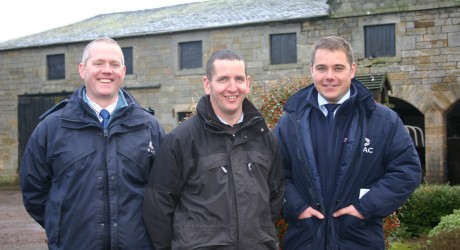CALF pneumonia was the main topic at the second meeting of the new Clyde monitor farm, hosted by Andrew Baillie of Carstairs Mains, a 650-acre unit in south Lanarkshire.
Bull beef is one of a variety of enterprises at Carstairs Mains. All the bull calves from the 75 cow suckler herd are kept entire. In addition, Mr Baillie annually purchases approximately 120, ten week-old dairy bull calves from two local dairy farms.
The dairy calves are double vaccinated on their farms of origin, with a combined viral and bacterial vaccine, to help protect them against some of the most common viruses and bacteria which cause pneumonia. Nevertheless, pneumonia is a problem for Mr Baillie.
Charles Marwood, a vet with the Clyde Vet Group, told the community group that to successfully control pneumonia it is important to consider the variety of causes of this complex disease, which reduces an animal’s liveweight gain and performance for its entire life.
“Pneumonia is a complex, multi-factorial disease, with important risk factors compounding viral and bacterial causes,” he said.
“In addition to vaccination, preventative measures should include good overall management with particular attention to specific risk factors.”
With input from the community group, Mr Marwood listed and explained some of the risk factors which can influence the chances of calves succumbing to pneumonia.
One key factor is stress which can result from: weaning; transport; the introduction of new calves to a group; mixed ages of cattle in a pen; tight stocking density; dehorning; and castration (though this does not apply to Mr Baillie’s bull beef enterprise).
Biosecurity is another key factor. Buying in cattle can increase the risk of bringing new diseases or parasites onto the farm.
Diet and nutrition is also a big influencing factor. The quantity and quality of colostrum a calf receives is fundamental to the protection of its health and sudden changes to a calf’s diet should be avoided.
Plenty of good quality roughage should be available as acidosis and/or mineral/trace element deficiencies are risked if calves receive too much concentrate without adequate roughage.
Bovine Viral Diarrhoea. (BVD) suppresses a calf’s immune system, significantly lowering its defences against health risks, in particular pneumonia.
Pneumonia bugs are killed by dry and cold conditions but thrive in a warm and wet environment. Humidity encourages the spread of pneumonia within a group of calves and can be fuelled by wet floors and coats as well as moisture rising from dung stored below slats. Also, as straw bedding builds up, it can compost, creating heat and humidity.
Poor ventilation contributes to a build-up of humidity and good air quality is important. The maintenance of a supply of fresh air reduces the risk of pneumonia. Good ventilation removes vapour from stock and aids evaporation from dung, bedding and water spillage, while also minimising condensation which helps to protect the fabric of the building.
“Good ventilation must work in a building on still, damp days. You can assess the quality of ventilation in a building while the cattle are in, by igniting a smoke-bomb,” explained Mr Marwood.
“By watching the smoke as it disperses, you can see how the air moves within the building. The ideal situation is for the smoke to disperse through the building’s roof within two minutes.”
At the time of the meeting, Mr Baillie’s suckler herd, with spring born calves at foot, were housed in a cattle shed. “This building was smoked bombed a while ago,” explained Mr Baillie. “And the smoke wafted up to the roof ridge and then rolled back down the sides of the building, showing that moisture and stale air were staying inside the building.
“Since then we’ve taken off the roof ridging above the feed passage. I was concerned that the open roof would result in the feed getting wet. Instead, when the stock are in during the winter, the feed passage is dry, but when the building is free of stock, the passage is wet.”
During the meeting Mr Marwood smoke bombed the building from among the cattle. The smoke dispersed through the open roof ridge within one minute, demonstrating that the ventilation is now working well.
Smoke did not, however, disperse as well from the building housing the finishing bulls. To improve air flow, the community group recommended the opening of the roof ridge, plus replacing corrugated sheeting at one end of the building, with Yorkshire boarding to allow more fresh air in.
The next Clyde monitor farm meeting will be in February when the topics will be soil compation, remedial actions, sward rejuvenation and fertiliser policy.
For more information on meetings please contact either of the joint facilitators Grant Conchie on 01555 662562 or email:grant.conchie@sac.co.uk or Raymond Crerar on 01292 525458 or email: Raymond.crerar@sac.co.uk
For general information on monitor farms plus detailed reports of meetings visit www.qmscotland.co.uk/monitorfarms
Caption: Monitor farmer Andrew Baillie (centre) flanked by facilitators Grant Conchie (left) of SAC Lanark and Raymond Crerar of SAC (Ayr).
MEDIA RELEASE posted by QMS. You too can post media releases (aka press releases) on allmediascotland.com. For more information, email here.
Contact: Claire Morrison
Phone: 01314724046
Email: cmorrison@qmscotland.co.uk
Website: http://www.qmscotland.co.uk






